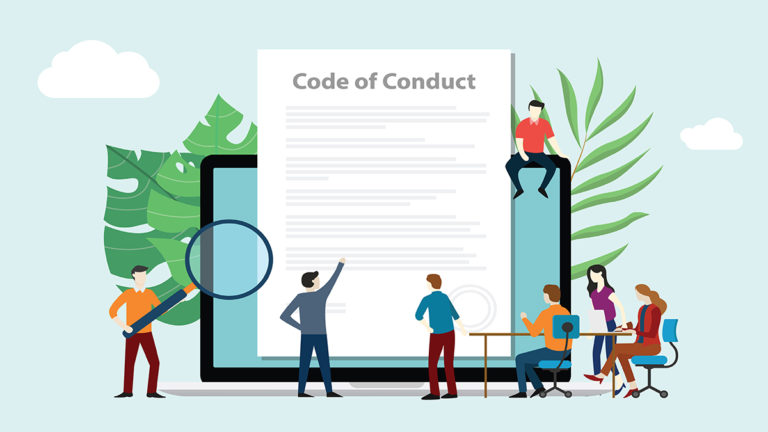7 Tips for a Good Code of Conduct
A code of conduct is a central pillar of good compliance. But where should a company start, what purpose should it serve and what is involved? We provide some practical tips on implementation.

While a code of conduct is not legally binding, it is indispensable for most companies. It outlines both the legal regulations and an organisation’s own requirements for ethical business practices while also providing all employees, up to the highest management level, with a framework for their conduct in the workplace. It also ensures transparency and helps protect the company from compliance violations that can result in criminal prosecution, heavy fines or damage to its image. Our article clarifies the most important questions about the code of conduct.
What is the code of conduct?
The code of conduct reflects the core values that an organisation stands for and is guided by when conducting business. It provides employees with behavioural guidelines in the workplace such as what constitutes desirable behaviour as well as actions to be avoided. It also defines the values of an organisation, sets standards of behaviour and with the help of individual programmes or processes, addresses risks and unethical behaviour such as bribery or corruption while setting out disciplinary measures.
What purpose does it serve?
The code of conduct is the foundation for many compliance guidelines and, therefore, also for successful compliance. It is based on existing legal foundations and transfers them to the immediate working environment. The basic standards of behaviour in an organisation are defined and employees are shown possible courses of action if a violation is observed, together with the possible consequences. As a result, the code of conduct acts as a guideline for employees to follow in the workplace and in their dealings with business partners. It provides the organisation with a regulatory framework for desirable behaviour and protects against compliance violations such as bribery or corruption.
What makes a good code of conduct?
Fundamentally, a good code of conduct fulfils three requirements: it fits the company, it covers its risks, and it remains familiar to all employees. In order to achieve this, it helps to follow a few tips.
- The regulations in the code of conduct are oriented towards the profile of the company. As well as addressing the organisation’s values, it also covers the risks it may be confronted with in the industry.
- The text is worded in a comprehensible way. Refrain from long and convoluted sentences and rather opt for short, concise statements. This way, confusion can be avoided.
- The document is easily accessible to all employees. Do not bury it in a remote folder on the company server. Make it accessible on the intranet or directly with the help of tools developed specifically for compliance communication such as Policies.
- The code of conduct is regularly updated and communicated. If the company expands its business area, the code of conduct must be adapted to the new circumstances. To ensure that employees are familiar with the code of conduct, its contents can be communicated during training courses.
The code of conduct should have been approved by the management and as with all compliance guidelines, tone from the top should apply! The management level should exemplify the regulations and therefore show the employees that your organisation takes ethical business conduct seriously.
How do you develop a code of conduct?
There are seven steps to developing a code of conduct.
- Compile the laws and regulatory requirements that apply to your industry and your company. Then define the values your organisation stands for. Conduct a risk analysis to define the potential risks your company may face as a result of doing business. For example, an internationally active company may also need to pay attention to bribery and corruption abroad. For instance, an SME supplying larger corporations may no longer be able to limit itself to risks around the domestic market due to supply chain legislation.
- Translate your findings into clear guidelines and instructions for your employees. How can legally required data protection be guaranteed? What gifts or invitations may employees accept? Think about the flip side and clearly define the consequences of violations. For example, what are the consequences of discrimination in the workplace? What happens if an employee accepts a bribe or actively tries to make a bribe?
- Write down the guidelines, making sure they are clear, concise and simple in order to avoid confusion or uncertainty among employees.
- If possible, have the code of conduct legally reviewed. In some areas, such as workplace relationships, companies can only impose limited requirements on their employees.
- Make the code of conduct public. If you operate internationally, consider having the code of conduct translated into the languages of your employees and business partners. Ensure that the document is easy to find and accessible to all employees.
- Make it clear when publishing the code of conduct that it is binding. New employees should directly receive it as soon as they start.
- The code of conduct is not a rigid document. If the legal situation changes or you expand your business field, the code of conduct must be adapted accordingly. Regular communication and training should keep your employees up to date on the current status.
Who does the code of conduct apply to?
First and foremost, the code of conduct applies to the entire company staff, from the employee to the board of the directors. However, many companies also make a point of ensuring that business partners and contract workers operating on their behalf also adhere to the code of conduct.

How to effectively create, implement and communicate compliance policies and measure the success of your policy program – for everyone who is responsible for Compliance policies in their organization





